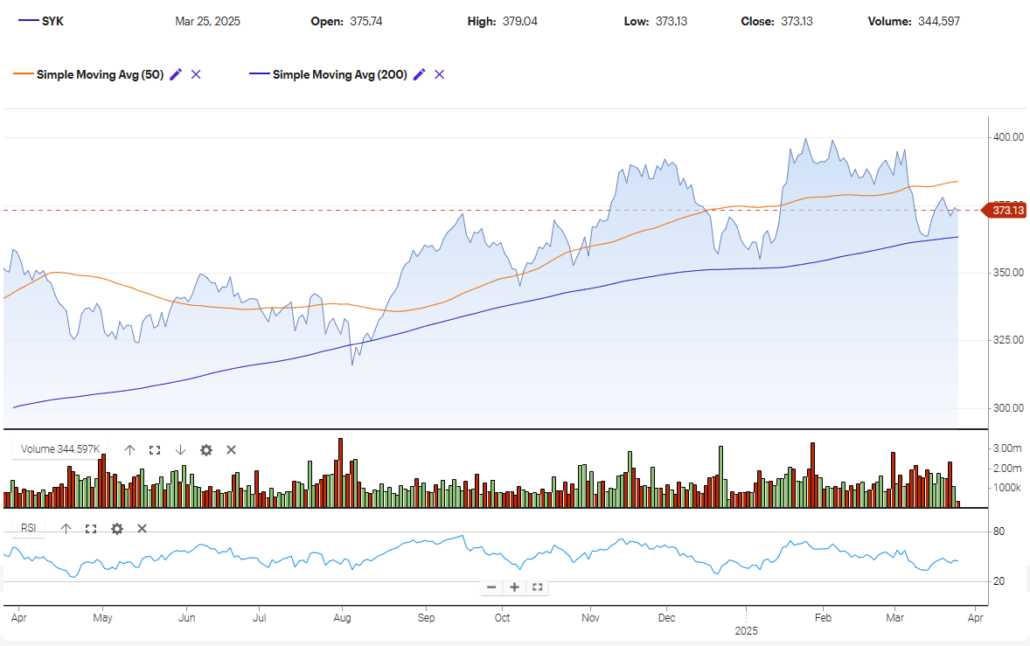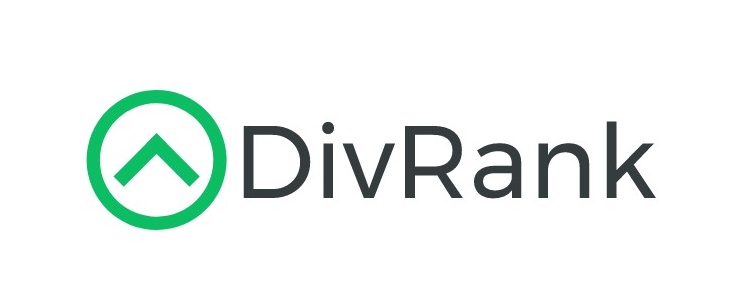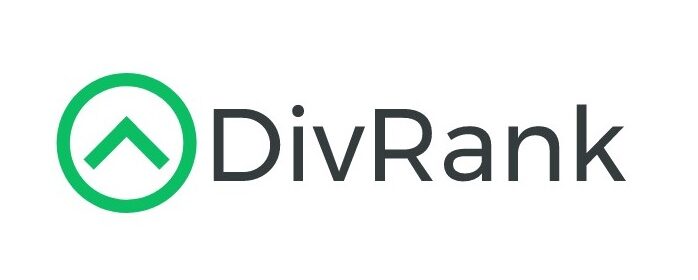Updated 3/26
Stryker isn’t a household name for most people, but if you’ve ever been in a hospital or operating room, there’s a good chance you’ve come across their products. From surgical robotics and implants to hospital beds and emergency care equipment, Stryker is everywhere in the healthcare system—quietly shaping the industry from behind the scenes.
Over the years, it’s grown into a massive player with a market cap north of $140 billion. And while it’s known more for growth and innovation than for flashy dividends, long-term investors have found a steady and dependable income stream here too.
Recent Events
Stryker wrapped up 2023 with strong top-line momentum. Revenue climbed to $22.6 billion over the trailing twelve months, growing more than 10% compared to the year before. Not bad for a company already operating at scale in a mature industry. However, earnings told a different story. Net income dropped over 50% year-over-year in the most recent quarter, driven by increased costs and investment in future growth initiatives.
That might make some investors nervous, but context matters. The company has been doubling down on R&D, acquisitions, and integrating newer technologies into its product line. Those investments don’t pay off right away, but they’re what keep Stryker competitive.
In the midst of it all, management raised the dividend again—something they’ve done without fail for decades.
Key Dividend Metrics
📈 Forward Dividend Yield: 0.91%
💵 Forward Annual Dividend: $3.36 per share
📅 Ex-Dividend Date: March 31, 2025
📊 Payout Ratio: 41.75%
📉 5-Year Average Dividend Yield: 1.03%
🧱 Dividend Growth Streak: 30+ years
🧮 Current Ratio: 1.95
📉 Total Debt to Equity: 68.4%
Dividend Overview
Stryker’s dividend yield won’t knock your socks off. Sitting just under 1%, it’s modest compared to high-yielding sectors like utilities or energy. But there’s a reason income investors still gravitate toward names like SYK: dependability.
This is the kind of dividend that doesn’t get cut. It gets raised, slowly but surely, year after year. With a payout ratio sitting under 42%, there’s plenty of cushion. That leaves room for reinvestment in the business while still rewarding shareholders.
Stryker isn’t trying to attract income chasers. Instead, it’s offering a steady baseline return that’s backed by real earnings power and strong fundamentals.
Dividend Growth and Safety
If you’re someone who values dividend growth more than the headline yield, Stryker’s worth a close look. This company has increased its dividend every single year for more than 30 years. That’s a track record few can match.
The pace of growth tends to be in the mid-to-high single digits annually. It’s not aggressive, but it’s reliable—and it mirrors the growth in free cash flow. That’s what you want to see. Dividends rising in step with profits, not ahead of them.
Safety-wise, things look just as solid. The company generated over $4.2 billion in operating cash flow last year, with levered free cash flow around $2.86 billion. That’s more than enough to cover the dividend and fund business expansion, even during a tougher earnings period.
Chart Analysis

Current Position in the Market Cycle
Stryker (SYK) appears to be in the late stages of a distribution phase, moving cautiously toward potential markdown territory. After a sustained markup phase that ran through late 2023 into early 2024, the stock experienced a strong rally, topping out near the 406 level. What followed is a textbook example of sideways movement with weakening momentum and erratic volume—signals that point toward institutional distribution rather than continued accumulation.
The price has been struggling to stay above the 50-day moving average, which recently turned downward. That’s often the early hint of a transition. At the same time, the 200-day moving average is still trending higher, showing that the longer-term structure hasn’t broken just yet. But when short-term averages start to fail repeatedly, and volume fades on upswings, it tends to hint that sellers are quietly taking profits.
Volume Behavior and Price Interaction
Volume tells an important part of this story. During the rally in late Q4 of 2024, buying volume was strong and consistent. But as the stock began to flatten out and retrace from highs, volume on down days increased while green volume bars during bounces became noticeably lighter. This imbalance usually reflects a shift from strong hands to weak hands—suggesting that larger players are offloading shares while retail participation tries to keep the price afloat.
Several spikes in red volume bars occurred on price dips, especially during the February and March pullbacks, highlighting a growing urgency to sell into strength. While there are still some bullish pockets, they’re getting less convincing with each rally attempt.
Moving Averages and Trend Structure
The 50-day simple moving average is now curling lower and acting more like resistance than support. This shift, though subtle, often marks the beginning of a bearish rotation. Price has dipped below this moving average multiple times recently, and the last attempt to break above it was met with rejection.
The 200-day moving average remains upward sloping, which tends to provide a buffer against immediate breakdowns. But as the price hovers in between these two lines, with no firm control by bulls or bears, it’s a sign of indecision—common during transitions between phases.
If this indecision resolves lower and price closes decisively below the 200-day average with confirmation from high selling volume, it would likely confirm the entry into markdown.
RSI Momentum Shift
The relative strength index (RSI) has been steadily declining since peaking during the late 2024 rally. It now sits in neutral territory, lacking the strength to push into overbought ranges. What stands out is how each attempt to recover in RSI has been shallower than the one before it. This is a classic sign of waning bullish momentum.
What’s even more telling is how the RSI barely reacted during the most recent bounce attempts, indicating that the push higher was half-hearted and lacked conviction. Momentum is clearly tilting to the downside, and bulls aren’t stepping in aggressively to defend key levels.
Candlestick Pressure Over the Last Five Sessions
Looking at the most recent five candles, there’s a noticeable shift in tone. The range has narrowed, but the wicks tell a subtle story. Two of the last five candles show longer upper shadows, hinting at sellers stepping in once price pushes above the 375–377 zone. That’s often where distribution meets resistance.
The most recent candle closes right near the day’s low, with very little wick below the body. That suggests selling pressure carried through to the close without much pushback from buyers. The drop in volume compared to earlier weeks means fewer participants were eager to chase the bounce, adding to the narrative that confidence is thinning.
Analyst Ratings
📊 Stryker Corporation has recently caught the attention of several analysts, with sentiment skewing largely positive. Across 33 analysts covering the stock, the consensus rating sits at Overweight, and the average 12-month price target has moved up to $430.76. Targets span a range from $402 on the low end to $465 on the high end, reflecting varying degrees of bullishness but a generally constructive outlook.
🔼 Barclays recently lifted its price target from $418 to $443, maintaining its Overweight stance. Their optimism stems from Stryker’s expanding margins and the consistent strength in MedSurg and Orthopaedics segments. The company’s ability to push forward despite higher input costs has made an impression.
💬 Argus also chimed in with an upward revision, bumping its price target from $410 to $450, continuing with a Buy rating. They noted Stryker’s solid execution in international markets and favorable demand trends for elective procedures as reasons to stay positive.
🔽 Goldman Sachs made a more measured move, slightly reducing its target from $427 to $422. While they remain supportive of the long-term fundamentals, they cited near-term earnings pressure and margin volatility as reasons for the modest adjustment.
📌 These shifts in analyst targets are being driven by a mix of strong product performance, particularly in robotic surgical tools and implants, along with steady cash flow generation. Analysts seem to be factoring in the company’s strategic positioning within the medtech space, where demand remains stable even in uncertain economic conditions.
💡 While upgrades and target changes like these don’t offer guarantees, they do suggest that Wall Street sees more upside than downside here, especially for longer-term holders looking for a blend of stability, innovation, and steady shareholder returns.
Earning Report Summary
Strong Top-Line Growth in a Challenging Environment
Stryker closed out 2024 with solid revenue numbers, showing they’re still able to grow even when the healthcare landscape gets a little bumpy. Fourth quarter sales came in at $6.4 billion, which was up 10.7% from the same time last year. That momentum was fueled by more procedure volume and a bit of pricing power—two things every medtech investor likes to see.
For the full year, total revenue hit $22.6 billion, up just over 10% from the previous year. It wasn’t just one part of the business doing the heavy lifting either—both of the company’s major segments contributed in a meaningful way.
Segment Performance: MedSurg and Ortho Carry the Load
The MedSurg and Neurotechnology side of the business brought in $3.9 billion for the quarter, up 10.6% year-over-year. That strength came from a mix of higher volumes and firm pricing, along with steady performance across most product lines. Over the full year, the segment added up to $13.5 billion in revenue, showing a strong 11.1% increase.
Orthopaedics wasn’t far behind. That segment delivered $2.5 billion in Q4, up 10.8% versus the same period in 2023. Full-year sales climbed to $9.1 billion, an increase of nearly 9%. Elective procedures have come back post-pandemic, and that’s helping this segment keep its footing.
Profit Takes a Hit, But There’s a Reason
While sales were strong, earnings told a different story. Net income fell to $500 million for the quarter, a steep 52% drop from the year before. For the full year, Stryker reported $3 billion in net earnings, down just over 5%. The drop wasn’t operational—it came largely from non-cash charges related to the company’s Spine business. A goodwill impairment charge of $818 million weighed heavily on the bottom line.
EPS for the quarter came in at $1.41, down more than 50%. However, if you strip out the impairment and a few other one-time costs, adjusted EPS actually rose 16% to $4.01 for the quarter and finished the year at $12.19, which was a 15% improvement over 2023.
Looking Ahead
Stryker’s guidance for 2025 suggests more steady growth. The company expects organic revenue to rise between 8% and 9%, and sees adjusted EPS landing somewhere between $13.45 and $13.70. That outlook assumes continued momentum in MedSurg and Ortho, along with a stable pricing environment.
The company is also making moves to tighten its focus. In a notable strategic shift, it’s divesting its U.S. spine business to Viscogliosi Brothers. That deal should close in the first half of 2025, giving Stryker more room to concentrate on higher-growth areas of the business.
Financial Health and Stability
Stryker’s balance sheet tells a story of stability. A current ratio close to 2 suggests it has no trouble meeting short-term obligations, and while the total debt of $14.1 billion might seem heavy, it’s manageable when set against its earnings and equity base.
Return on equity is sitting at 15.26%, which is strong for a company that doesn’t rely heavily on leverage to juice results. Return on assets of 7.47% rounds out a picture of operational efficiency.
Margins are also healthy. The gross margin is high, and operating margin comes in at a solid 25.6%. Despite the temporary pullback in net income, Stryker continues to generate strong profits, supported by a wide product portfolio and steady demand.
Valuation and Stock Performance
Stryker isn’t cheap, and it’s probably never going to be. With a forward P/E around 27 and a PEG ratio just above 2, investors are clearly paying a premium for quality. This is the price of consistency and innovation in the medical device space.
Looking at the stock chart, SYK has been treading water a bit. Over the past year, the share price is up just under 3%, trailing the broader market. But that’s par for the course. Stryker isn’t the kind of stock that rockets higher. It tends to move steadily, compounding returns over time with less drama.
At its recent price around $367, shares are trading between the 52-week low of $315 and the high of $406. The 50-day and 200-day moving averages sit around $384 and $363 respectively, suggesting a technically supported level in the current range.
Risks and Considerations
No company is risk-free, and Stryker does face a few worth noting. The earnings drop in the last quarter, while not catastrophic, is a reminder that even strong companies hit speed bumps. If margin pressures stick around longer than expected or if R&D spending doesn’t translate into future revenue, it could weigh on profitability.
Another layer of risk comes from healthcare policy and regulation. Changes in reimbursement structures or stricter regulatory hurdles can directly impact product adoption and revenue.
Currency exchange is another wildcard. Stryker sells across the globe, and a stronger U.S. dollar can dilute the value of international sales and earnings.
Lastly, while the debt load is currently under control, higher interest rates could increase financing costs in the future. It’s not a red flag, but something to keep on the radar.
Final Thoughts
Stryker is a quiet performer in the dividend world. You won’t see it topping any yield charts, but that’s not really the point here. This is a company that grows its payout year after year, backed by a resilient business and strong financials.
For investors focused on income stability, dividend growth, and long-term compounding, Stryker fits nicely. It’s a name you can hold through market cycles without losing sleep—and that’s a valuable trait in any portfolio.
While it may not be the flashiest choice, it has a lot going for it under the surface. Sometimes, the best dividend stocks are the ones that just quietly do their job.

